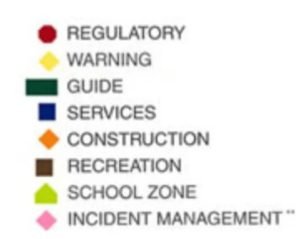Introduction
Traffic signs don’t just use words and shapes — their colors carry important meanings too. Drivers must be able to instantly recognize what a sign means based on its color, even before reading the text or symbol. There are eight basic traffic sign colors, and each has a specific purpose.
The Eight Basic Colors of Signs and Their Meanings
-
Red – Stop, yield, or prohibited actions
-
Used for STOP signs, YIELD signs, DO NOT ENTER, and WRONG WAY signs.
-
Red always means stop or restriction.
-
-
White – Regulatory information
-
Background for speed limits, lane use, and parking regulations.
-
White signs tell you what you must do or what is legally required.
-
-
Yellow – General warning
-
Used for caution signs such as curves, intersections, merging lanes, or pedestrian crossings.
-
Yellow means be alert, conditions ahead may change.
-
-
Orange – Construction and maintenance warning
-
Used for road work, detours, and temporary traffic control.
-
Orange signs mean slow down and watch for workers or equipment.
-
-
Green – Guide and directional information
-
Used for highway exits, distance signs, and directional arrows.
-
Green helps drivers navigate routes and destinations.
-
-
Blue – Services and information
-
Indicates gas stations, food, lodging, hospitals, and rest areas.
-
Blue signs are for traveler services and helpful information.
-
-
Brown – Parks and recreation
-
Directs to state and national parks, historical sites, picnic areas, or recreation facilities.
-
Brown signs highlight cultural and recreational points of interest.
-
-
Fluorescent Yellow-Green – School zones, pedestrians, and bicycles
-
A brighter version of yellow, used for school crossings, pedestrian crossings, and bicycle warnings.
-
Demands extra caution because children and cyclists may be nearby.
-
Safety Tip
By memorizing these sign colors, you’ll know the general meaning at a glance — even before you can read the sign’s words or symbols. This saves time and keeps you alert while driving.
Conclusion
Traffic sign colors are part of the road’s communication system.
-
Red = Stop or Prohibited
-
Yellow = General Warning
-
Orange = Construction
-
Green = Direction/Guidance
-
Blue = Services
-
Brown = Recreation
-
White = Regulations
-
Fluorescent Yellow-Green = School Zones / Pedestrians
Memorize them — because on your driving test (and in real life), knowing sign colors quickly can save lives.

